Hydrangeas In All Their Glory
Can you think of a more beloved plant in New England than the Hydrangea? Its flowers have many forms, ranging from beautiful rounded mopheads in shades of blue, to showy panicles in shades of pink and white, to delicate lacecap flowers in tones of pink and blue. New varieties are expanding the range of flower color into the red spectrum. In terms of size, there are varieties ranging from 2’ to 6’ in height. And the climbing hydrangea is as beautiful as it is unusual. This means there is a hydrangea for every location.
Types of Hydrangeas
There are 6 species of hydrangea commonly grown in our area.
Hydrangea macrophylla
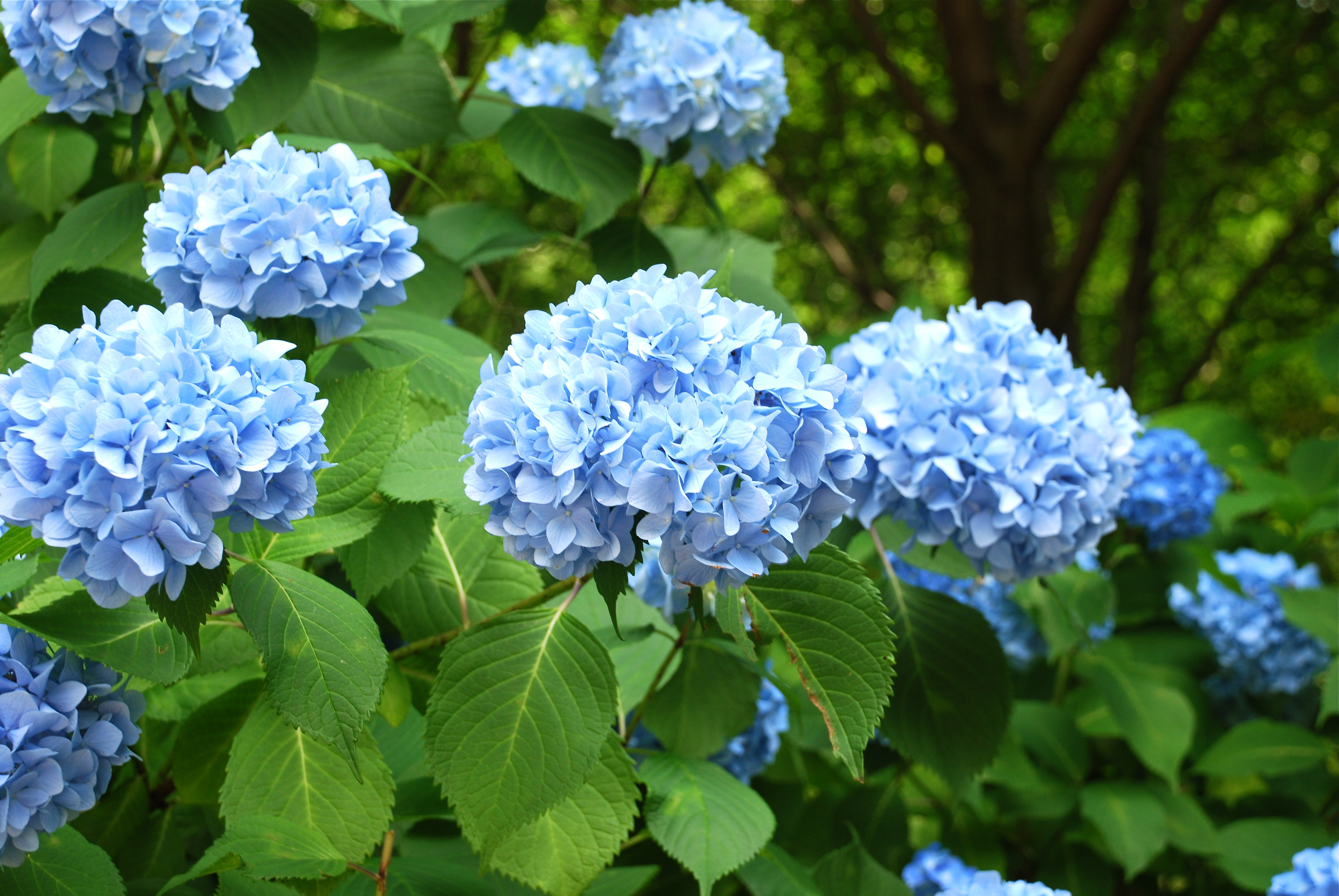
japanese ajisai/hydrangea
Perhaps the most familiar is Hydrangea macrophylla (known as mophead or bigleaf hydrangea). In addition to the rounded mophead flower form, Hydrangea macrophylla also comes in a lacecap flower form. These are flat to slightly domed flower heads with many small florets in the center and larger, showier florets around the edges, creating an elegant and lacy flower form. ‘Twist ‘n’ Shout’ and ‘Wedding Gown’ are examples of the lacecap form of Hydrangea macrophylla. In terms of mophead flowers, there are many varieties from which to choose. ‘Nantucket Blue’, ‘Endless Summer’, ‘Bloomstruck’, ‘Blushing Bride’, ‘Let’s Dance Blue Jangles’, ‘Let’s Dance Rave’, ‘Let’s Dance Rhythmic Blue’ and ‘LA Dreamin’ all have mophead type flowers. A new introduction with raspberry red mophead flowers is ‘Summer Crush’.
Hydrangea paniculata
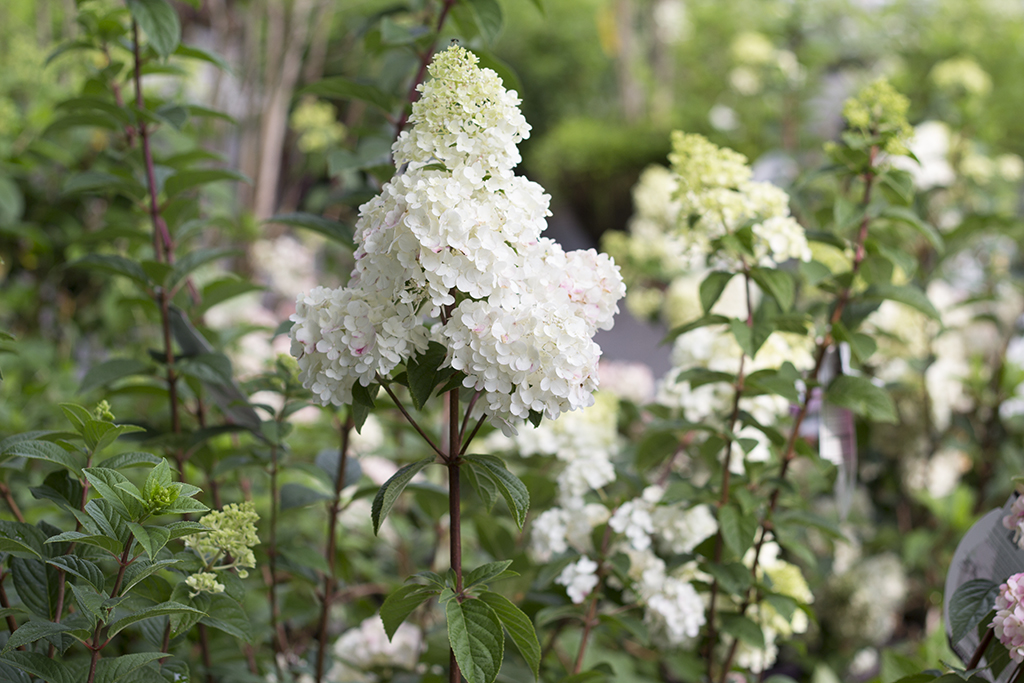
Hydrangea paniculata (panicle hydrangea) has large cone-shaped flowers. Reliable bloomers, panicle hydrangeas subtly change color over their many months of bloom. Soft green buds open to creamy white flowers which morph into varying shades of pink, and with some varieties, even red by season’s end. Some panicle hydrangeas come in full size versions which grow to 6’-8’ and in smaller versions which grow 4’-5’ in height (‘Quick Fire’ / ‘Little Quick Fire’ and ‘Limelight’ / ‘Little Lime’). The smallest variety is ‘Bobo’ which bears large white flowers on a shrub that reaches only 3’ in height. Varieties such as ‘Pinky Winky’, ‘Strawberry Sundae’ and ‘Zinfin Doll’ showcase flowers in different shades of color from bottom to top.
In addition to the shrub form, paniculatas such as ‘Limelight’, ‘Pink Diamond’ and ‘Quick Fire’ are available in tree form. Growing atop a short trunk, this unique form adds stature, structure and scale to the garden. Depending on the variety, they will grow 6’-10’ in height, making a dramatic statement in the landscape.
Hydrangea arborescens
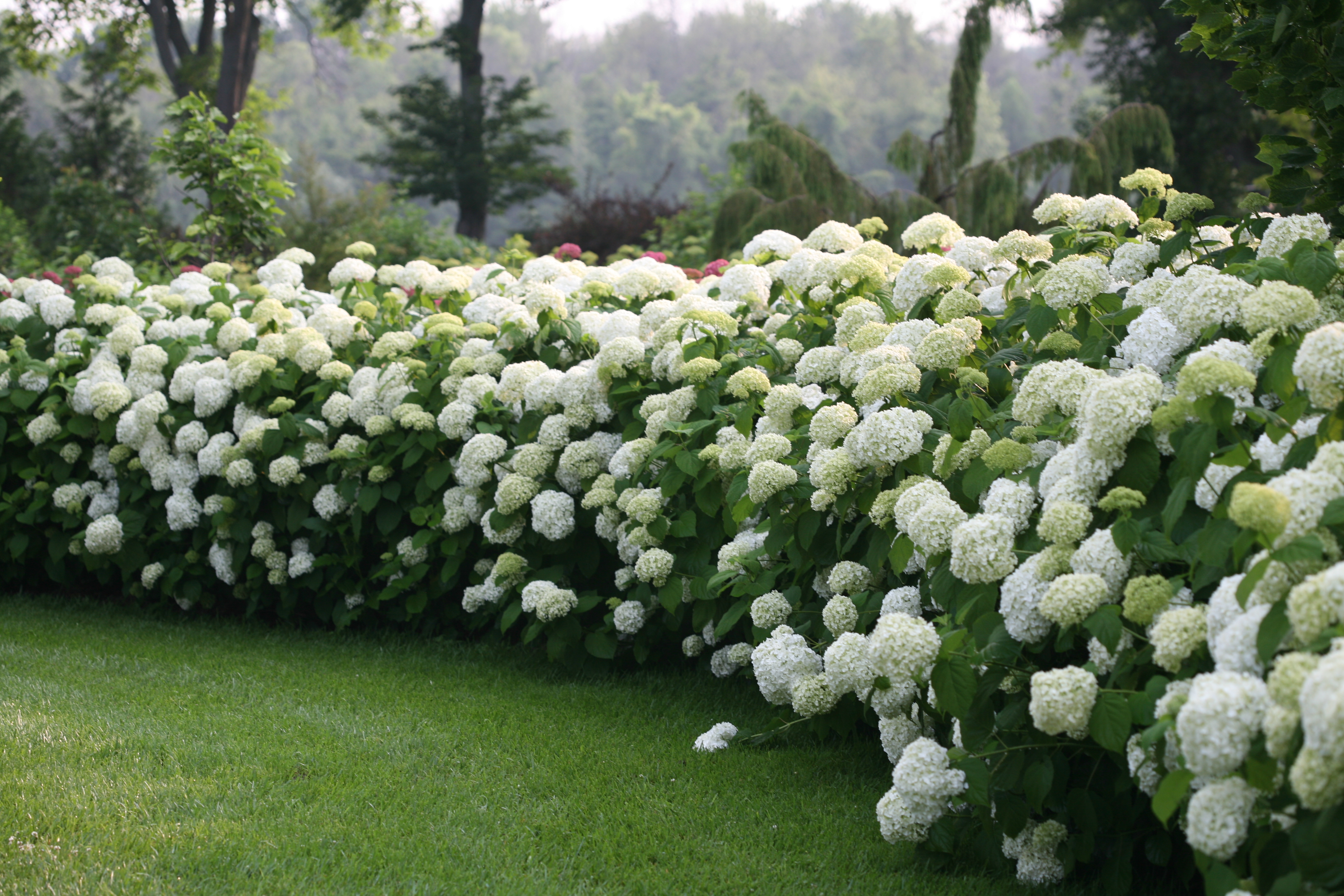
Hydrangea arborescens (smooth hydrangea) is quite shade tolerant. It has showy dome shaped white flowers. The well-known variety ‘Annabelle’ has dramatic, large white flowers. ‘Annabelle’ has been joined by the ‘Incrediball’ and ‘Invincibelle’ series which offer pink varieties in addition to white.
Hydrangea serrata
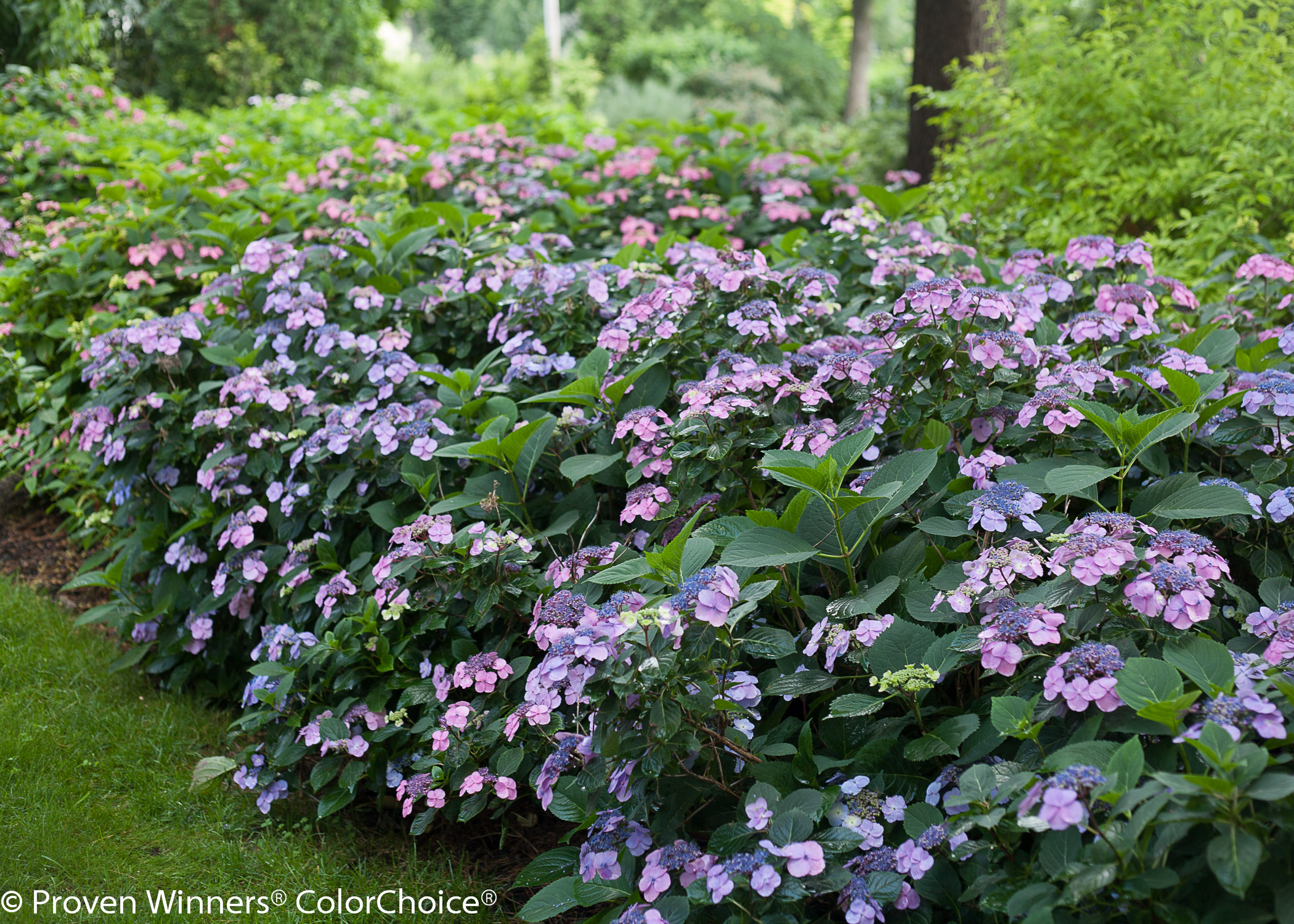
Hydrangea serrata (mountain hydrangea) is very cold tolerant and seldom damaged by winter conditions. The elegant lacecap flowers attract pollinators, a bonus in any garden. ‘Bluebird’ has light blue flowers while newer varieties such as those in the ‘Tuff Stuff’ series offer stronger tones ranging from bright pink to purple blue.
Hydrangea quercifolia
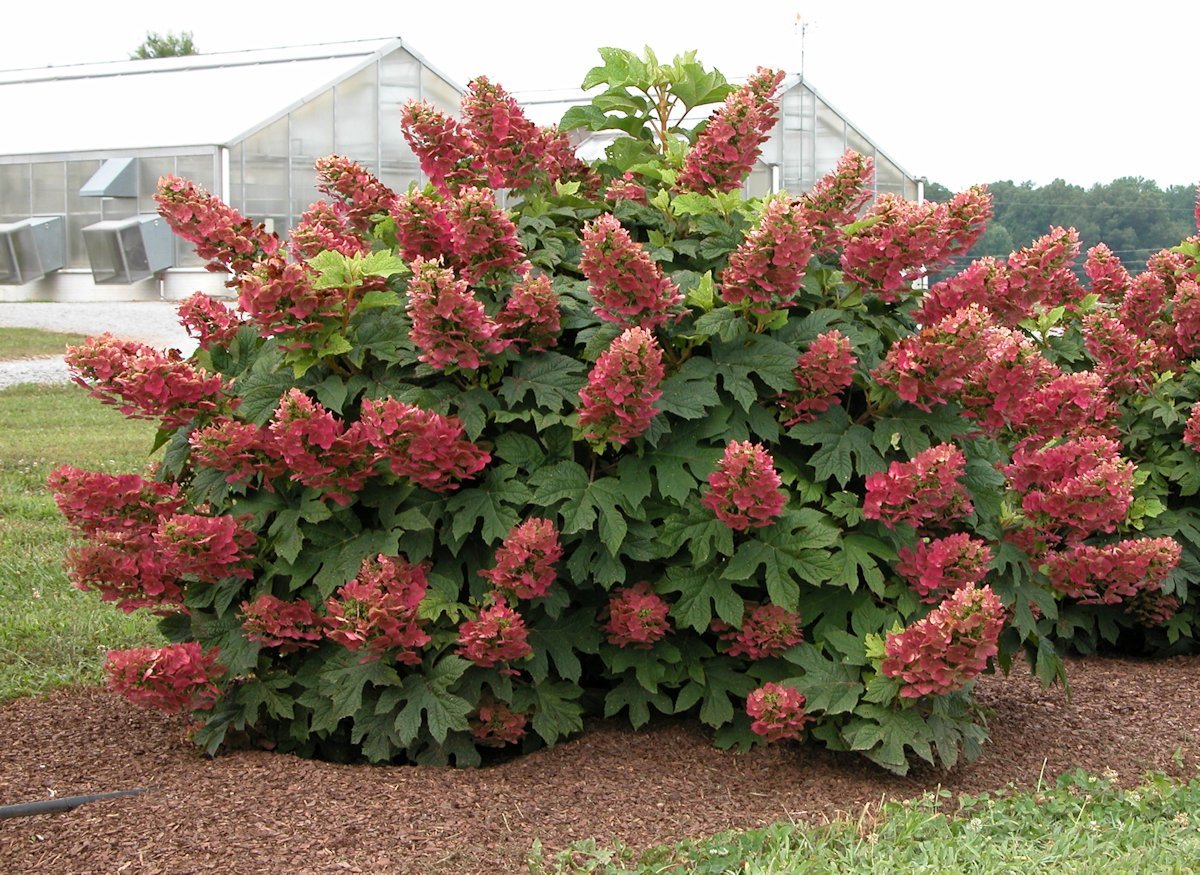
Hydrangea quercifolia (oakleaf hydrangea) is a striking and unusual form of hydrangea. The leaves are large and resemble oak leaves, hence its common name. Dark green in summer, the leaves turn mahogany red in fall. Flowers are large panicles in white or pink, depending on the variety. Hydrangea quercifolia has exfoliating bark which becomes more pronounced with age. The beautiful bark adds considerable winter interest to the landscape. Varieties such as ‘Alice’ and will reach 6’-8’ in height and width. ‘Snow Queen’ and ‘Gatsby Gal’ are slightly smaller. ‘Sikes Dwarf’ matures at just 3’-4’. The white flowers of ‘Ruby Slippers’ quickly mature to deep pink. It is similar in size to ‘Sikes Dwarf’. ‘Snowflake’ and ‘Gatsby Star’ have showy white double blossoms that are arranged in layers.
Hydrangea petiolaris
Hydrangea petiolaris is commonly known as climbing hydrangea. It is slow to establish and follows the axiom “first it sleeps, then it creeps, then it leaps”. It clings and climbs to fencing or other structures by twining and aerial rootlets along its stems. Horizontal lateral branches can extend several feet. The foliage is heart shaped. Large fragrant white flowers appear in June. A mature specimen growing along a fence or up a tree is a thing of beauty. The woody vine adds texture and interest throughout the winter.
General Information
In the garden, the first hydrangeas come into bloom just after the first flush of roses is fading. Beginning in late June and continuing into the fall, they offer a strong presence and a long season of interest in the garden. The flowers will subtly change color as they mature. They often remain on the plant into and through the winter, fading to a lovely tan color. Leaves on some types of hydrangea turn beautiful tones of red and mahogany in the autumn. The stems of the plants remain upright through the winter, adding structure and form to the winter landscape.
For optimal flowering, hydrangeas require 4 hours of sun each day, ideally in the morning. The hot afternoon sun can cause mophead hydrangeas to wilt. Panicle hydrangeas are the most sun tolerant in our area, thriving in anything from full sun to part shade conditions. Hydrangea quercifolia (oakleaf hydrangea) and Hydrangea arborescens (smooth hydrangea) are the most shade tolerant.
Hydrangeas love the naturally occurring acidic (pH below 7) nature of our New England soils. The pH of our soils allows aluminum to be readily available to the roots and the more aluminum that is absorbed, the more intensely blue the flowers will be. It is rarely necessary to add supplemental aluminum to the soil. For those whose taste runs more to the pink tones, plant breeders have introduced a number of varieties that stay true to color. This means there is no need to try to adjust the soil pH from our naturally occurring acidic pH to a more alkaline pH. Trying to adjust soil pH requires making chemical applications in specific amounts at specific times. It takes considerable effort and is not particularly effective.
Planted in good soil and light conditions, hydrangeas require little fertilizer. In fact, over-fertilizing will likely result in big green leaves but few flowers. Hydrangeas do not require yearly fertilizing. An older shrub might benefit from the occasional application of a granular, show-release fertilizer with a high percentage of phosphorus (the middle number in the NPK ratio). Phosphorus is the element that encourages bloom. A fertilizer with a high percentage of nitrogen (the first number in the NPK ratio) will encourage leaf growth at the expense of flower production.
Hydrangeas require plenty of water, particularly as they are getting established. Their root systems are quite shallow and dry out quickly. Regular and deep watering is important, as is well-draining soil. They will not tolerate wet feet. A two inch layer of mulch around the base of the plants will help insulate the plants in winter and keep the soil from drying out too quickly in summer. As with any mulch, do not mound it up against the stems of the plant.
Pruning
When and how to prune hydrangeas are frequently asked questions. The short answer is that hydrangeas require very little pruning. Too frequent or vigorous pruning can remove flower buds, frustrating both the plant and the gardener. A more complete answer involves several factors.
Hydrangeas require 2 or more years to develop their root system and become established in the garden. Optimal flower production occurs on mature plants so try to be patient during those first two years.
It is important to understand when hydrangeas form their flower buds. Some types of hydrangeas set their flower buds on the new season’s growth (ie. in the spring). This is referred to as blooming on new wood. Hydrangea paniculata (panicle hydrangea) and Hydrangea arborescens (smooth hydrangea) both bloom on new wood. If they require pruning (to remove last year’s flower heads that remained through the winter or to reduce the height of wayward stems) it should be done in late winter or very early spring while the plant is still dormant. Hydrangea macrophylla (bigleaf hydrangea) and Hydrangea serrata (mountain hydrangea) form their flower buds at the end of the current year’s blooming season. The flower buds go dormant as winter approaches and open in the following summer season (referred to as blooming on old wood). If pruned in spring, the result will be a lack of flowers. Another factor, particularly in the case of Hydrangea macrophylla, is that in harsh winters the dormant flower buds may be damaged, either by extreme cold or by an unusually warm period in winter followed a return to frigid conditions. The introduction of reblooming hydrangeas (the ‘Endless Summer’ series and the ‘Let’s Dance’ series, for example) has allowed for more reliable flowering as these plants bloom on both old wood and new wood. Pruning reblooming hydrangeas runs the risk of removing flower buds from old and/or new wood.
Hydrangea paniculata (panicle hydrangea) blooms on new wood. It can be pruned in late winter or very early spring to remove any remaining flower heads from last summer or to reduce the height of the plant.
Hydrangea serrata (mountain hydrangea) blooms on old wood. Very little pruning is required. The ‘Tuff Stuff’ series has introduced the ability to bloom on both old and new wood. As with other rebloomers, pruning runs the risk of removing flower buds from old and/or new wood.
Hydrangea quercifolia (oakleaf hydrangea) and Hydrangea petiolaris (climbing hydrangea) take a number of years to mature to their full flowering capacity. They bloom on old wood. It is best to avoid pruning unless absolutely necessary.
It is also worth noting that hydrangeas are among the very last plants to leaf out each year. A stem that appears lifeless in mid-May may yet leaf out. Wait until Memorial Day and even June 1 to determine if there are any dead stems. They will often pull out of the plant with a gentle tug, another indication they are no longer viable.
Hydrangeas are long lived and healthy shrubs that offer some of the most spectacular blooms to be found in the garden. When sited properly, they give us multiple seasons of interest with very little care. They can be grown as individual specimens or planted en masse to form a hedge. They combine well with other plants, adding interest and structure to the mixed border. Smaller varieties can even be grown in containers. It is hard to imagine gardening in New England without them!
